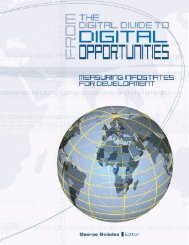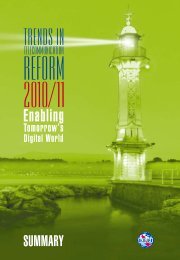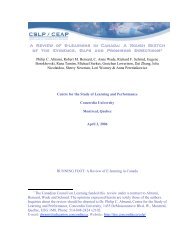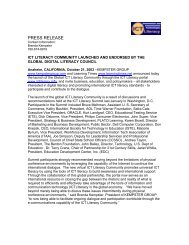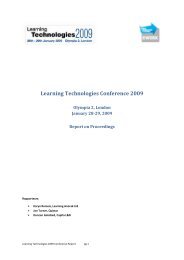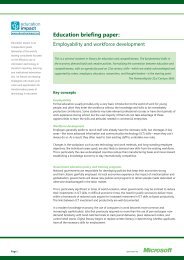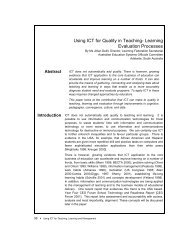147 pages pdf - ICT Digital Literacy
147 pages pdf - ICT Digital Literacy
147 pages pdf - ICT Digital Literacy
You also want an ePaper? Increase the reach of your titles
YUMPU automatically turns print PDFs into web optimized ePapers that Google loves.
Content, Content (Not To Mention Content) … How To Best Design & Deliver It<br />
#267: Design Components That Make Sense<br />
When designing an online course, it is important to take into consideration performance aspects. One<br />
way of doing this is to analyze who the audience is, what resources are they likely to have, and then<br />
decide on the audio/video/multi-media kind of components.<br />
Vidya Nagaraj<br />
Oracle<br />
#268: Be Search Minded<br />
Create searchable databases as entry points to the training. This supports the learner's need for just-in-time training<br />
and allows designers and developers the ability to mine content and create courses with reduced cycle times.<br />
Phil Antonelli<br />
Intellinex<br />
#269: Lean, Mean, And Real Target Questions<br />
As with all training, remember your audience and keep the content relevant to them. For example, if<br />
you were training new sales people and wanted to include assessment questions, use questions that<br />
are relevant to what they'll find in the field. For example, consider including common questions (FAQ)<br />
customers ask, scenario-based questions such as which product best meets a specific need, benefits<br />
of clients working with your organization and/or different product lines, questions that integrate sales<br />
skills with product knowledge (where they would go to get help in different types of situations, product<br />
positioning questions, competitive advantages questions, etc.)<br />
Rebecca Koos<br />
RacePoint Consulting LLC<br />
#270: Do The Math<br />
We have found that a combination of highly structured, audio-driven tutorials coupled with flashbased<br />
simulations are a great way to engage the learner in understanding difficult mathematical<br />
concepts, such as that encountered in finance, economics and statistics. The tutorial explains the<br />
concept and presents the math. The simulation allows the learner to visually experience the impact<br />
of changing any independent variable, without having to actually do any math. This is a great tool for<br />
allowing the non-mathematically inclined individual to understand the intuition that drives the concept,<br />
without having to understand the underlying mathematics.<br />
Robert Ironside<br />
Learning Dividends Inc<br />
#271: Respect Copyrights<br />
It’s easy to borrow content from other sites on the Internet. Most people are flattered if you want<br />
to borrow an image or some text, provided they receive appropriate credit. But if you’re using<br />
someone else’s materials, be sure to find out if the content is copyrighted. The Internet is filled<br />
with pirated images so even if it appears that something isn’t marked, it could be stolen already.<br />
Jeff Harris<br />
Trivantis Corporation<br />
#272: Think Movie, A Motivating Metaphor<br />
Creating true e-Learning is equivalent to turning a novel into a movie -- the important parts are<br />
selected and acted out in simplified, recognizable scenes.<br />
Ulrik Ramsing<br />
LogiLearn, Inc.<br />
#273: Our I/D Goal<br />
Good instructional designers who are open minded and who understand business and people.<br />
Anna Soin<br />
LearningLab<br />
701 e-Learning Tips by The MASIE Center www.masie.com 55





